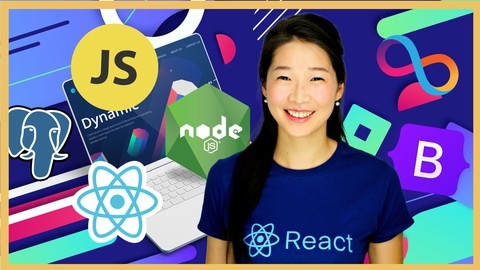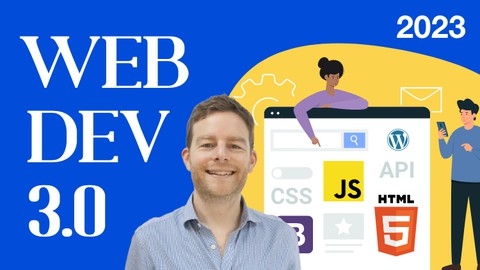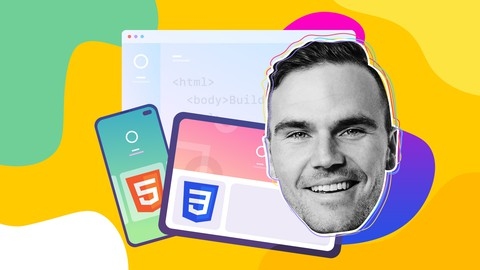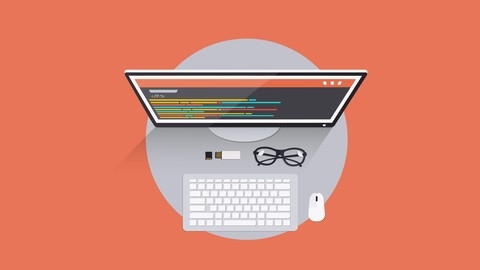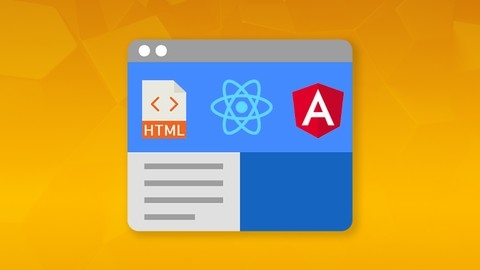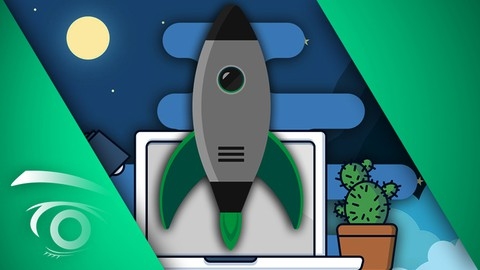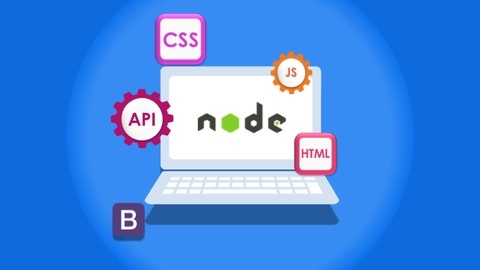Learning web development can open doors to a rewarding career, but finding the right course can feel overwhelming with so many options available.
You might be looking for a comprehensive course that covers everything from front-end to back-end, or you might be interested in a specific area like React.js or Node.js.
No matter your goal, there’s a course out there that can help you achieve it.
We’ve reviewed countless web development courses on Udemy and have compiled a list of our top picks.
For the best overall web development course, we recommend The Complete 2024 Web Development Bootcamp by Angela Yu.
This course is highly regarded for its comprehensive coverage of both front-end and back-end technologies, as well as its emphasis on practical projects.
You’ll learn to build a wide range of applications, from simple websites to complex DApps, giving you a solid foundation in the latest web development technologies.
But that’s not all!
We’ve also included a range of other options based on different learning styles and goals.
Keep reading to explore courses focused on specific technologies, frameworks, and career paths, and find the perfect one for you.
The Complete 2024 Web Development Bootcamp
The course starts with an introduction to front-end web development, covering HTML, CSS, and Bootstrap.
You’ll learn how to create visually appealing websites using these technologies.
The course then moves on to JavaScript, teaching you the latest ES6 syntax and how to manipulate the Document Object Model (DOM) to add interactivity to your websites.
One of the standout features of this course is the emphasis on practical projects.
You’ll build several projects, including a dice game, a drum kit, and a Simon game, which will help you solidify your understanding of the concepts you’ve learned.
The course also covers back-end web development with Node.js and Express.js.
You’ll learn how to create servers, handle HTTP requests, and use templating engines like EJS.
Additionally, you’ll dive into databases, including SQL and PostgreSQL, and learn how to store and retrieve data.
Another highlight of the course is the section on authentication and security, where you’ll learn how to handle user credentials securely and implement features like “Sign In with Google.”
The course then introduces you to React.js, a popular JavaScript library for building user interfaces.
You’ll learn how to create React components, manage state, and build complex applications like a note-taking app.
Towards the end, the course takes an exciting turn by introducing you to Web3 and decentralized app (DApp) development on the Internet Computer (ICP) blockchain.
You’ll build DApps like a decentralized bank (DeFi) and an NFT marketplace, giving you a glimpse into the future of web development.
Throughout the course, you’ll also learn about version control with Git and GitHub, APIs, and deployment.
The instructor, Angela Yu, provides valuable tips and insights on topics like habit building, dealing with distractions, and freelancing.
The Complete Web Developer Course 3.0
You’ll start by learning HTML5, the standard markup language for creating web pages.
The course covers everything from structuring a webpage to adding images, forms, tables, and multimedia elements like audio and video.
Next, you’ll dive into CSS3, the language for styling webpages.
You’ll learn how to apply colors, fonts, and layouts, as well as advanced techniques like gradients, animations, and flexbox.
The course even includes a project where you’ll build a portfolio website from scratch.
Moving on, you’ll explore JavaScript, the programming language that adds interactivity to websites.
You’ll learn how to access and manipulate elements on a page, respond to user events, and create simple games and applications.
The course also covers jQuery, a popular JavaScript library that simplifies common tasks.
The curriculum then introduces you to Bootstrap, a powerful front-end framework for building responsive and mobile-first websites.
You’ll learn how to use its grid system, components, and utilities to create modern, professional-looking interfaces.
For those interested in content management systems, the course covers WordPress, teaching you how to install, customize, and manage a WordPress site, including working with themes, plugins, and creating posts and pages.
If you want to dive deeper into server-side programming, the course covers PHP and MySQL.
You’ll learn how to create dynamic websites, handle user input, send emails, interact with databases, and even build a weather scraper application.
The course also touches on important topics like APIs, allowing you to integrate external data and services into your applications.
You’ll work with APIs like Wikipedia, Twitter, and a cat image API.
For those interested in web hosting and deployment, the course covers essential concepts like domain names, DNS, FTP/SFTP, and backing up your website.
Additionally, the course introduces you to the Linux command line, Python programming, and Search Engine Optimization (SEO) techniques to help your websites rank higher in search engines.
Throughout the course, you’ll work on various projects, quizzes, and challenges to reinforce your learning and build a portfolio of practical work.
UX & Web Design Master Course: Strategy, Design, Development
This comprehensive course takes you through the entire process of building a website - from defining the strategy and planning to designing the user interface and finally coding it into a live website.
The course begins by teaching you how to lay the proper foundations for a successful website project.
You’ll learn how to determine the goals, requirements, and value proposition through user and stakeholder research.
This crucial definition phase ensures you build something people actually need and want.
Next, you dive into information architecture - organizing the content and navigation in an intuitive way.
You’ll learn techniques like creating sitemaps, wireframing, and validating the architecture through user testing.
Having a solid IA makes the design and development phases much smoother.
The design section covers core UI/UX principles to create user-friendly and visually appealing interfaces.
You’ll learn how to design for different devices, organize information hierarchically, and apply consistent styling.
Step-by-step exercises guide you through designing interfaces for various types of sites like blogs, e-commerce stores, and business websites.
In the development module, you get hands-on practice building three different websites - a basic HTML/CSS site, a WordPress blog, and an e-commerce store with WooCommerce.
You start from the basics of HTML/CSS and work your way up, learning how to structure, style, and add functionality.
For WordPress and WooCommerce, you learn how to install, configure, customize themes, and manage content/products.
The instructor walks you through every step with clear video explanations and exercises to solidify the concepts.
You’ll not only learn the technical skills but also best practices for planning, collaborating with clients/teams, and quality assurance before launch.
Node with React: Fullstack Web Development
The course starts by setting up the server-side architecture with Node and Express.
You’ll learn how to generate Express apps, handle routes, and deploy to platforms like Heroku and Render.
Authentication is implemented using Google OAuth, giving you hands-on experience with the OAuth flow and Passport.js.
MongoDB is then integrated as the database, covering everything from setting up Atlas to creating models and handling queries.
You’ll dive deep into authentication, encoding users, managing sessions, and logging in/out.
The focus then shifts to the client-side, where you’ll generate a React app and learn how to run it alongside the server.
Redux is introduced for state management, and you’ll build out components like the header and landing page.
Importantly, you’ll handle payments using Stripe’s API, allowing users to purchase credits.
As you progress, you’ll create surveys that can be emailed out, leveraging services like SendGrid (or Mailgun) for email delivery.
Webhooks are implemented to track user feedback, involving techniques like data parsing and processing pipelines.
The course culminates with fetching and displaying surveys, giving you a complete full-stack application.
Along the way, you’ll encounter real-world challenges like handling different environments (dev vs. prod), version control, and deployment strategies.
Ultimate Web Designer & Web Developer Course
This comprehensive course starts by introducing you to the fundamentals of visual design principles like color theory, typography, grids, and more.
You’ll learn industry-standard tools like Figma for designing websites and user interfaces.
The course then dives deep into HTML, CSS, and cutting-edge technologies like CSS Flexbox.
One of the standout sections is on JavaScript, where you’ll build a functional tip calculator application.
You’ll also learn jQuery, a popular JavaScript library, and create a mini-game using it.
The course covers Bootstrap, a powerful front-end framework for building responsive websites quickly.
You’ll gain expertise in back-end development with PHP and MySQL.
Through hands-on projects, you’ll build a client address book application, learn to create login systems, and convert static websites into dynamic ones.
There’s even a dedicated section on WordPress, covering themes, plugins, and eCommerce setups.
You’ll constantly apply your learning by designing and developing your custom website throughout the course.
By the end, you’ll have a professional portfolio piece to showcase your skills.
Brad’s teaching style is clear, concise, and engaging.
He breaks down complex concepts into easy-to-understand lessons, guiding you step-by-step with practical examples and projects.
The course is well-structured, allowing you to progress seamlessly from beginner to advanced topics.
Build Websites from Scratch with HTML & CSS
The course starts by introducing you to HTML and CSS - the core languages for building websites.
You’ll learn what they are, why they’re important, and get an overview of HTML tags, attributes, and elements.
Right off the bat, you’re taught best practices for naming and organizing your website files and folders like a pro.
The first major section dives into the foundations of HTML.
You’ll learn how to structure an HTML document, add headings, paragraphs, text formatting, links, lists, images, and more.
The lessons build up logically, letting you get hands-on coding practice with mini coding exercises along the way.
By the end, you’ll understand advanced HTML5 elements like nav, section, article, and aside.
Next up is an in-depth look at CSS foundations.
You start with the basics of styling rules, selectors, properties, and values.
The course covers the different ways to add CSS to a site, including external stylesheets which is the recommended approach.
You’ll work with various CSS selectors like IDs, classes, and descendants to precisely target elements.
Other key CSS concepts like the box model, colors, text styling, backgrounds, and form styling are all covered.
The final section ties everything together as you build a complete website step-by-step.
You’ll code the HTML structure, then style it with CSS following best practices.
The lectures guide you through every part of the site - the header, hero section, content areas, footer, and more.
By the end, you’ll have a modern, responsive website you coded yourself.
The course wraps up by discussing next steps for continuing your web development journey.
The Complete Front-End Web Development Course
The course starts by teaching you the fundamentals of HTML - the building blocks of web pages.
You’ll learn how to structure HTML documents, use different elements like divs, spans, lists, headers, footers, and tables.
Once you have a solid grasp of HTML, the course dives into advanced concepts like forms, inputs, videos, audios, and meta tags.
Next up is CSS, the language for styling web pages.
You’ll learn how to target and modify colors, backgrounds, fonts, text decorations, and more.
The course also covers advanced CSS techniques like pseudo-states, border radius, positioning, z-index, transitions, and handling overflowing content.
A significant portion is dedicated to JavaScript - the programming language that adds interactivity to websites.
You’ll start with basics like variables, operators, loops, functions, and event handling.
Then move on to arrays, classes, constructors, and extending classes.
The course even walks you through writing your own version of the popular jQuery library.
Speaking of jQuery, you’ll learn how to use this powerful library to simplify JavaScript coding.
Topics include targeting elements, event handling, dropdown menus, prepending/appending content, and preventing default behaviors.
The course also covers Bootstrap, a CSS framework for quickly building responsive websites.
You’ll learn to create navbars, forms, buttons, and more using Bootstrap’s components.
To apply what you’ve learned, you’ll build two major projects - a Pipboy interface from Fallout 4 using HTML/CSS/Bootstrap, and a Google Chrome extension for downloading online videos.
There’s even a bonus section on coding another Chrome extension!
Throughout the course, you’ll gain hands-on experience with tools like Atom (a code editor), Chrome’s developer console, and Chrome’s downloads API.
The instructor provides tips for getting started as a professional web developer too.
Beginner Full Stack Web Development: HTML, CSS, React & Node
You’ll start by learning the fundamentals of HTML and CSS, including how to structure web pages, style them with colors, backgrounds, and more.
The course covers essential concepts like selectors, specificity, and responsive design principles like flexbox and CSS grids.
As you progress, you’ll dive into JavaScript, the language that brings interactivity to websites.
You’ll learn variables, arrays, loops, functions, and how to manipulate the DOM.
This prepares you for learning React, a popular JavaScript library for building user interfaces.
With React, you’ll create reusable components and manage state, crucial skills for modern web apps.
But this course doesn’t stop at the front-end.
You’ll also learn back-end development with Node.js and MongoDB.
You’ll build RESTful APIs, handle HTTP requests, work with JSON data, and integrate a MongoDB database.
This full-stack knowledge is invaluable for creating complete, data-driven web applications.
Along the way, you’ll pick up other vital skills like version control with Git, using developer tools like Chrome DevTools, and deploying your apps to a live server.
The course even covers Bootstrap 4 for rapid UI development and Sass for more maintainable CSS.
With a project-based approach and hands-on exercises, you’ll gain practical experience building websites and web apps from scratch.
Web Development Masterclass - Online Certification Course
The course starts by introducing you to key internet concepts like data packet transmission, protocols, and bandwidth.
You’ll learn about HTTP and HTTPS protocols, email exchange using SMTP, and the basics of networks and firewalls.
This lays a solid foundation for understanding the web development process.
Next, you’ll dive into planning a website, exploring different web hosting options like shared hosting, VPS, dedicated servers, and cloud hosting.
You’ll learn how to register a domain name, manage it using control panels like GoDaddy, and set up a testing environment with WAMP or MAMP.
The course then takes you through the core web development technologies: HTML, CSS, JavaScript, and jQuery.
You’ll learn how to structure web pages, style them with CSS, add interactivity with JavaScript, and leverage the power of the jQuery library.
You’ll also work with the popular Bootstrap framework for responsive web design.
You’ll also learn server-side programming with PHP, including form handling, data validation, and database integration with MySQL.
You’ll explore XML and AJAX for seamless data exchange with the server.
The course culminates in a comprehensive development project where you’ll build a web application with features like user authentication, registration, database creation, email transmission using PHPMailer, and AJAX for alert messages.
Throughout the course, you’ll gain hands-on experience by working on various projects and quizzes to reinforce your learning.
You’ll also learn about cloud computing, deploying a virtual instance on Linode, and securing your server with SSL certificates.
By the end of this course, you’ll have a solid understanding of web development concepts and the skills to build professional-grade websites and web applications.
The Complete Web Development Course - Build 15 Projects
The course starts with an introduction to web development, explaining how websites work and guiding you through setting up a web hosting account and FTP client to upload your projects.
You’ll then dive into HTML, learning how to structure web pages, add headings, paragraphs, links, images, lists, tables, forms, and more.
The course covers both the basics and advanced HTML concepts like iframes and HTML entities.
Next, you’ll learn CSS, which is essential for styling and decorating your websites.
The course covers inline, internal, and external CSS, as well as advanced topics like the box model, backgrounds, positioning, text formatting, image sprites, gradients, transforms, transitions, and animations.
You’ll also build a professional Mathematics Tutorials website project to apply your HTML and CSS skills.
The course then moves on to JavaScript, teaching you how to add interactivity to your websites.
You’ll learn variables, data types, functions, objects, arrays, control statements, loops, events, and more.
Additionally, you’ll build a Maths Game project using HTML, CSS, and JavaScript.
The course introduces you to jQuery, a popular JavaScript library that simplifies web development.
You’ll learn how to select and manipulate HTML elements, handle events, create effects and animations, and work with jQuery UI components like draggable/droppable elements, accordions, date pickers, and sliders.
You’ll also build a Fruits Slice Game project using jQuery and jQuery UI.
Moving forward, you’ll learn Twitter Bootstrap, a powerful front-end framework for building responsive websites.
The course covers Bootstrap’s grid system, typography, forms, buttons, navigation bars, modals, and various other components.
You’ll build several professional projects, including an App Landing Page, a Company Website, and a website for showcasing the course itself, using Bootstrap.
The course also covers modern JavaScript (ES6), introducing new features like let/const, arrow functions, destructuring, template literals, and classes.
You’ll learn Node.js, a JavaScript runtime that allows you to run JavaScript on the server-side, and build an Online File Explorer App using Node.js and Bootstrap.
The course then dives into PHP, a server-side scripting language used for building dynamic websites.
You’ll learn variables, data types, control structures, functions, form handling, file uploads, email sending, and more.
You’ll also learn MySQL, a popular database management system, and build an Online Notes App using PHP, MySQL, AJAX, and Bootstrap.
Additionally, the course covers WordPress, teaching you how to create blogs, customize themes, add plugins, and build professional pages like an About Page and a Contact Page with Google Maps integration.
You’ll learn how to use Google Maps APIs to embed maps, add markers, calculate distances, geocode addresses, and implement features like autocomplete and nearby search.
You’ll build a Distance Between Cities app using HTML, CSS, jQuery, and the Google Maps API.
The course also covers integrating social widgets from Facebook, Google+, and Twitter into your websites, as well as creating mobile apps using jQuery Mobile.
You’ll build a Speed Reader app for iOS and Android platforms.
Finally, the course culminates with a comprehensive project: a Car Sharing Website built using JavaScript, PHP, MySQL, AJAX, JSON, and various APIs.
This project will test your skills in building a complete, real-world website.
Throughout the course, you’ll have access to source code files, quizzes, and professional projects that reinforce the concepts you’ve learned.
The instructor provides clear explanations and guides you step-by-step, ensuring you gain practical experience in web development.
Also check our posts on:
